Resources
About Us
Organic Spirulina Market Size, Share & Forecast 2025-2035 | Growth Analysis by Product Type, Applications & Geography
Report ID: MRFB - 1041511 Pages: 145 Jun-2025 Formats*: PDF Category: Food and Beverages Delivery: 24 to 72 Hours Download Free Sample ReportKey factors driving the growth of the organic spirulina market include the rising consumer preference for clean-label and certified organic products, increasing awareness of premium health benefits associated with organic spirulina, stringent organic certification standards ensuring superior quality, growing demand for organic natural food colorants, expanding organic nutraceuticals industry, and rising willingness to pay premium prices for sustainable and environmentally-friendly products. However, this growth is restrained by higher production costs and premium pricing, limited organic certified production capacity, complex organic certification processes, and lower yields compared to conventional spirulina cultivation.
Additionally, untapped markets in developing regions with growing organic awareness, development of innovative organic product formulations, expansion of direct-to-consumer organic sales channels, integration with the broader organic food ecosystem, and rising demand for organic aquaculture applications are poised to offer significant growth opportunities for market players. The adoption of sustainable packaging for organic products and vertical integration in organic supply chains are emerging as notable trends in this market.
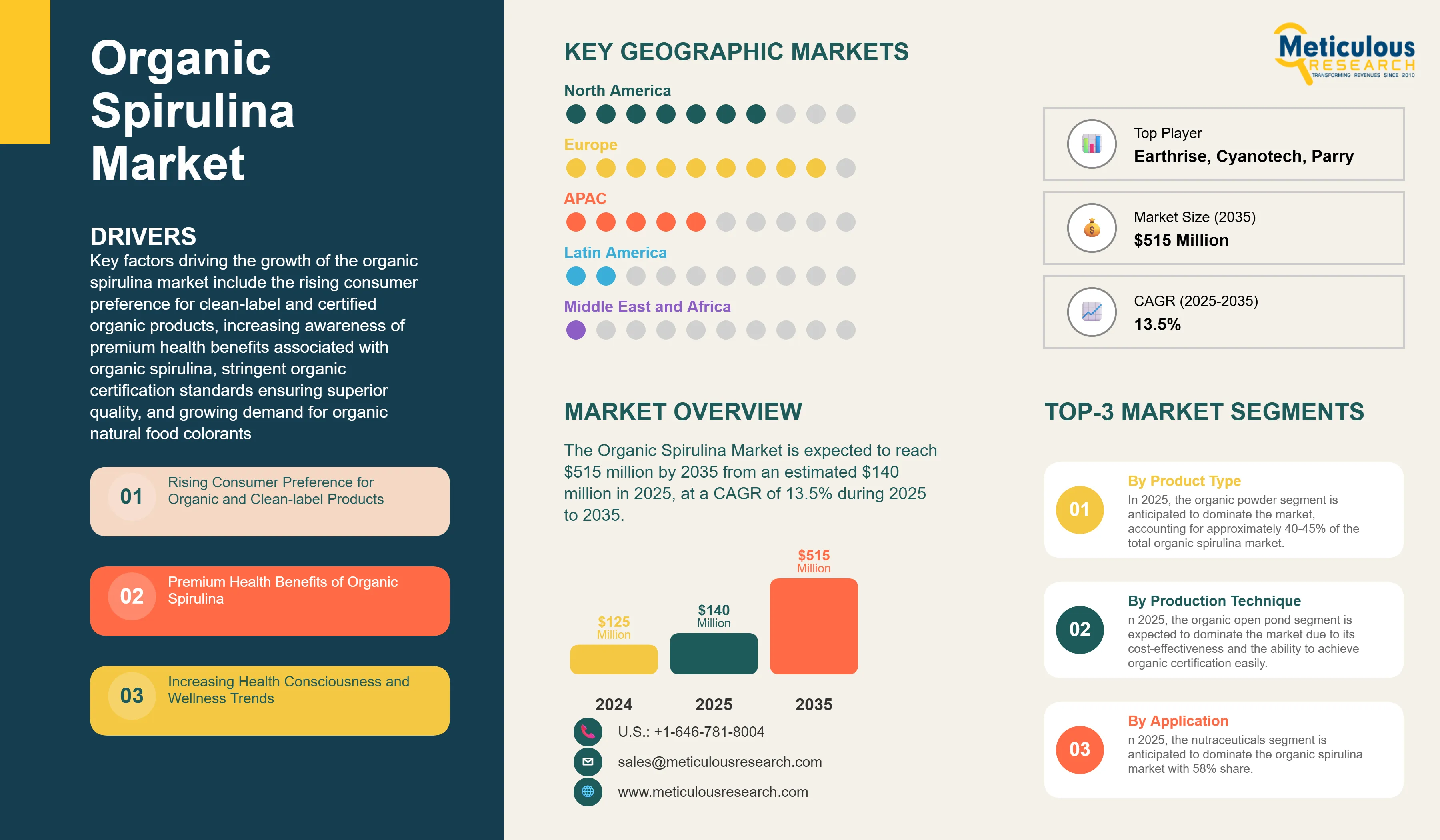
Market Drivers
Rising Consumer Preference for Organic and Clean-Label Products
The demand for organic spirulina is experiencing unprecedented growth due to increasing consumer awareness about the benefits of organic products and the growing preference for clean-label ingredients. Modern consumers are increasingly concerned about synthetic additives, pesticide residues, and chemical contaminants in their food and supplements, driving them toward certified organic alternatives. The organic spirulina market benefits from this trend as consumers seek products that are free from synthetic fertilizers, pesticides, and genetic modifications.
The adverse effects of synthetic additives, coupled with a rise in health consciousness and a preference for environmentally friendly products, are driving this trend. Organic spirulina, being produced without synthetic inputs and under strict organic certification standards, appeals to health-conscious consumers who prioritize product purity and safety. This preference is particularly strong among millennials and Gen Z consumers who are willing to pay premium prices for products that align with their health and environmental values.
The clean-label movement has gained significant momentum in recent years, with consumers demanding transparency in product ingredients and production methods. Organic spirulina, with its simple ingredient profile and certified organic status, perfectly aligns with these consumer expectations, driving its adoption across various applications.
Premium Health Benefits and Superior Nutritional Profile
Organic spirulina offers enhanced health benefits compared to conventional spirulina due to its purer cultivation environment and absence of synthetic contaminants. The organic production process, which prohibits the use of synthetic fertilizers and chemicals, results in a cleaner product with potentially higher bioavailability of nutrients. Research suggests that organic spirulina may contain higher levels of certain antioxidants and beneficial compounds due to the stress-response mechanisms activated in organic cultivation environments.
Spirulina is regarded as a nutritional powerhouse due to its high protein content, which includes all eight essential amino acids in balanced proportions. It is also rich in beta-carotene, vitamin E, and iron. Organic spirulina maintains these nutritional benefits while providing additional assurance of purity and safety, making it particularly attractive to health-conscious consumers, athletes, and individuals with dietary restrictions.
The growing body of research supporting spirulina's health benefits, combined with the premium positioning of organic variants, has led to increased adoption among consumers seeking natural alternatives to synthetic supplements and functional foods.
Expanding Organic Nutraceuticals Industry
In recent decades, the use of dietary supplements, including vitamins, minerals, and nutritional and herbal supplements, has been on the rise. This trend was further accelerated during the COVID-19 pandemic, with a notable increase in supplement sales. The organic segment of the nutraceuticals industry is experiencing even faster growth as consumers increasingly prioritize natural and certified organic ingredients in their health and wellness routines.
The organic nutraceuticals market is being driven by an aging population with heightened health awareness, increased focus on preventive healthcare, and growing consumer education about the benefits of organic supplements. Organic spirulina, being recognized as a complete superfood with multiple health benefits, is positioned to capture a significant share of this growing market.
Furthermore, healthcare professionals and nutritionists are increasingly recommending organic supplements due to their perceived safety and efficacy advantages, further driving the demand for organic spirulina products.
Market Segmentation Analysis
By Product Type
Based on product type, the organic spirulina market is segmented into powder, tablets, capsules, flakes, phycocyanin, and fresh/frozen spirulina. In 2025, the organic powder segment is anticipated to dominate the market, accounting for approximately 40-45% of the total organic spirulina market. The dominance of organic powder is attributed to its versatility in application, cost-effectiveness for manufacturers, and consumer preference for customizable dosing in smoothies, functional foods, and DIY health preparations.
However, the organic phycocyanin segment is projected to record the highest CAGR during the forecast period of 2025-2035. This exceptional growth is driven by the premium pricing of organic phycocyanin, its increasing use in high-end natural food coloring applications, growing demand in organic cosmetics formulations, and its positioning as a super-premium ingredient in the organic health and wellness market.
The organic capsules segment is also experiencing robust growth due to consumer preference for convenient, standardized dosing and the premium positioning of organic supplements in the dietary supplements market.
By Production Technique
The organic spirulina market is segmented into organic open pond systems, organic photobioreactor systems, and organic hybrid production systems. In 2025, the organic open pond segment is expected to dominate the market due to its cost-effectiveness and the ability to achieve organic certification more easily compared to complex closed systems.
However, the organic photobioreactor segment is anticipated to record the highest growth rate during the forecast period, driven by its ability to produce ultra-premium organic spirulina with consistent quality, reduced contamination risks, and higher productivity per unit area. The controlled environment of photobioreactors aligns well with the stringent requirements of organic certification while enabling year-round production regardless of climatic conditions.
By Distribution Channel
Based on distribution channel, the organic spirulina market is segmented into business channel (B2B) and consumer channel (B2C). Unlike the overall spirulina market where B2B dominates, the organic spirulina market shows a more balanced distribution with the B2C segment accounting for approximately half of the market in 2025. This is attributed to the premium nature of organic spirulina products, consumer willingness to pay premium prices, and the direct-to-consumer marketing strategies employed by organic brands.
The B2C segment is further driven by the growth of organic specialty stores, health food retailers, e-commerce platforms specializing in organic products, and the increasing availability of organic spirulina in mainstream retail channels.
By Application
The organic spirulina market is segmented into nutraceuticals, food & beverages, cosmetics, animal feed, and agriculture. In 2025, the nutraceuticals segment is anticipated to dominate the organic spirulina market with a share of 58%, higher than the overall spirulina market due to the premium positioning of organic supplements and the willingness of health-conscious consumers to pay premium prices for certified organic products.
The organic food & beverages segment is projected to record the highest CAGR of 14.8% during the forecast period of 2025-2035, driven by the rapid expansion of the organic food industry, increasing use of organic spirulina as a natural colorant in premium food products, and growing consumer demand for organic functional foods and beverages.
Regional Analysis
Based on geography, the organic spirulina market is segmented into North America, Europe, Asia-Pacific, Latin America, and the Middle East & Africa. In 2025, Europe is anticipated to account for the major share of around 45% of the organic spirulina market, reflecting the region's well-established organic food culture, stringent organic regulations, and high consumer awareness about organic products.
The market in Europe is slated to record a strong CAGR of 13.2% during the forecast period of 2025–2035. This growth is fueled by the shift towards natural colorants, an increased emphasis on preventive health measures, a rising consumption of functional foods, and a growing demand for environmentally sustainable products. For organic spirulina specifically, Europe's leadership is further strengthened by the EU's comprehensive organic certification framework, high consumer purchasing power, and strong demand for premium organic products.
North America follows as the second-largest market, driven by the USDA Organic certification program, high health consciousness among consumers, and the presence of leading organic spirulina brands. The region's strong e-commerce infrastructure and direct-to-consumer organic brands contribute significantly to market growth.
Asia-Pacific is emerging as the fastest-growing region for organic spirulina, with a projected CAGR of 16.4% during 2025-2035, driven by increasing organic awareness in countries like Japan, Australia, and urban areas of China and India, rising disposable incomes, and growing health consciousness among the middle class.
Competitive Landscape
The organic spirulina market is characterized by a mix of specialized organic producers, conventional spirulina manufacturers with organic divisions, and premium health and wellness brands. Leading players in the global organic spirulina market include Earthrise Nutritionals LLC, Cyanotech Corporation, Parry Nutraceuticals, Algosource SA, Allmicroalgae Natural Products S.A., Sea & Sun Organic GmbH, Far East Bio-Tec Co., Ltd., Organic Spirulina India Pvt. Ltd., Australian Organic Spirulina Co., Pond Technologies Inc., Algae Health Sciences, DIC Corporation, and Hydrolina Biotech among others. These companies are focusing on strategies such as organic certification expansion, premium product development, sustainable packaging initiatives, direct-to-consumer marketing, and partnerships with organic food manufacturers to strengthen their market position.
|
Particulars |
Details |
|
Number of Pages |
145 |
|
Forecast Period |
2025–2035 |
|
Base Year |
2024 |
|
CAGR (Value) |
13.5% |
|
Market Size 2024 |
USD 125 million |
|
Market Size 2025 |
USD 140 million |
|
Market Size 2035 |
USD 515 million |
|
Segments Covered |
By Product Type, Production Technique, Distribution Channel, Application |
|
Countries Covered |
North America (U.S., Canada), Europe (Germany, France, U.K., Italy, Netherlands, Spain, Denmark, Sweden, and Rest of Europe), Asia-Pacific (Japan, Australia, India, China, Thailand, and Rest of Asia-Pacific), Latin America (Brazil, Mexico, Argentina, and Rest of Latin America), and the Middle East & Africa (South Africa, UAE, Egypt, and Rest of Middle East & Africa) |
The organic spirulina market is projected to reach USD 515 million by 2035 from USD 140 million in 2025, at a CAGR of 13.5% during the forecast period.
In 2025, the organic powder segment is projected to hold the major share of the organic spirulina market.
The organic food & beverages segment is slated to record the highest growth rate during the forecast period of 2025–2035.
Key factors driving the growth include rising consumer preference for clean-label and certified organic products, increasing awareness of premium health benefits, stringent organic certification standards ensuring quality, growing demand for organic natural food colorants, expanding organic nutraceuticals industry, and rising willingness to pay premium prices for sustainable products.
Major opportunities include untapped markets in developing regions, development of innovative organic product formulations, expansion of direct-to-consumer organic sales channels, integration with the broader organic food ecosystem, and rising demand for organic aquaculture applications.
Europe leads the market with the highest share, while Asia-Pacific is projected to record the highest growth rate during the forecast period, offering significant opportunities for organic spirulina vendors.


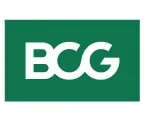
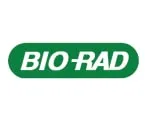
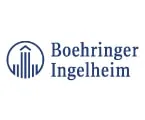

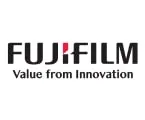

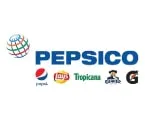
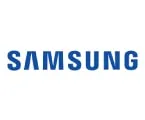


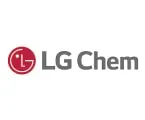



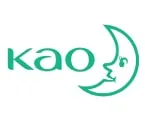

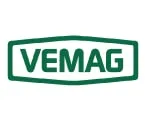
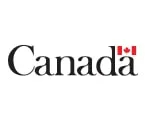

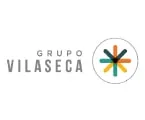


Published Date: Jan-2025
Published Date: Jan-2025
Published Date: Jan-2025
Published Date: Sep-2024
Published Date: Apr-2023
Please enter your corporate email id here to view sample report.
Subscribe to get the latest industry updates